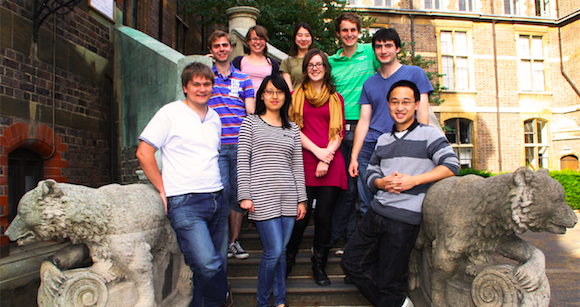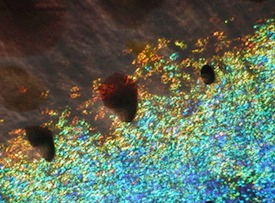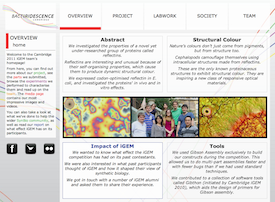
iGEM2011 project
Reflectins - iridescent proteins
The Cambridge iGEM2011 team worked with bionanophotonic systems - experimenting with the use of self-assembling protein structures from squid that produce striking iridescence in vivo.
They produced BioBrick compatible forms of squid reflection, expressed and purified the protein, and produced thin films with bright and dynamic reflectance properties (see right). The films responded in fractions of a second to physical changes, such as humidity-induced film swelling. Reflectins form a new class of potential biosensors with radically improved properties.
The team also produced improved software for Gibson Assembly, with an interface to sequence libraries (including the iGEM Registry), graphical construction tool and automated PDF output of oligo design and experimental protocol.
iGEM 2011 Students
Marta Bozek: 2nd Year Biology
Xin (Heather) Gao: 2nd year Engineering
Joe Harvey: 2nd Year Mathematics
Matthew Jones: 2nd Year Biology
Haydn King: 2nd year Engineering
Catriona McMurran: 2nd Year Biology
Jonathan Very: 2nd Year Biology
Katy Wei: 2nd Year Physics
Felix Zhou: 2nd Year Engineering
Reflectins - iridescent proteins
The Cambridge iGEM2011 team worked with bionanophotonic systems - experimenting with the use of self-assembling protein structures from squid that produce striking iridescence in vivo.
They produced BioBrick compatible forms of squid reflection, expressed and purified the protein, and produced thin films with bright and dynamic reflectance properties (see right). The films responded in fractions of a second to physical changes, such as humidity-induced film swelling. Reflectins form a new class of potential biosensors with radically improved properties.
The team also produced improved software for Gibson Assembly, with an interface to sequence libraries (including the iGEM Registry), graphical construction tool and automated PDF output of oligo design and experimental protocol.
iGEM 2011 Students
Marta Bozek: 2nd Year Biology
Xin (Heather) Gao: 2nd year Engineering
Joe Harvey: 2nd Year Mathematics
Matthew Jones: 2nd Year Biology
Haydn King: 2nd year Engineering
Catriona McMurran: 2nd Year Biology
Jonathan Very: 2nd Year Biology
Katy Wei: 2nd Year Physics
Felix Zhou: 2nd Year Engineering

Background
Cephalopods use rapidly changing patterns of surface colour for camouflage and communication. These dynamic surface patterns are regulated by chromatophores and iridescence under nervous system control.
Squid iridescence is due to the presence of nanophotonic structures that are found in epidermal tissues. composed of a family of highly unusual proteins, relectins, which have atypical amino acid content, high in sulphur-containing and aromatic amino acids, and with no obvious homologues. Reflectins form characteristic platelets within iridisome cells. The platelets form bands of high and low refractive index, which confer iridescent properties.
Images:
1. Loligo vulgaris squid (http://crossmediaschweiz.net/)
2. Iridescence in Loligo opalescens (Danny DeMartini, UCSB)
3. Platlet-containing iridisomes in squid (Mathger et al., J Exp Biology 207, 1759-1769, 2004)
4. Electron micrograph of reflectin-containing platelets (Neurophysiology blog) (top to bottom)
Cephalopods use rapidly changing patterns of surface colour for camouflage and communication. These dynamic surface patterns are regulated by chromatophores and iridescence under nervous system control.
Squid iridescence is due to the presence of nanophotonic structures that are found in epidermal tissues. composed of a family of highly unusual proteins, relectins, which have atypical amino acid content, high in sulphur-containing and aromatic amino acids, and with no obvious homologues. Reflectins form characteristic platelets within iridisome cells. The platelets form bands of high and low refractive index, which confer iridescent properties.
Images:
1. Loligo vulgaris squid (http://crossmediaschweiz.net/)
2. Iridescence in Loligo opalescens (Danny DeMartini, UCSB)
3. Platlet-containing iridisomes in squid (Mathger et al., J Exp Biology 207, 1759-1769, 2004)
4. Electron micrograph of reflectin-containing platelets (Neurophysiology blog) (top to bottom)




